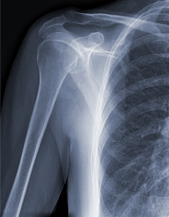- Home
- Patient Care
- Services
- Shoulder & Elbow
- Treatment Approach
Treatment Approach
 Washington University Orthopedics uses a multi-disciplinary approach to the evaluation and management of shoulder and elbow disorders. Initial treatment begins with a comprehensive evaluation. For many patients, conservative treatment and rehabilitation options are highly successful. Among the non-surgical procedures performed to relieve pain and improve function is the use of fluoroscopic-guided injections into painful or arthritic joints.
Washington University Orthopedics uses a multi-disciplinary approach to the evaluation and management of shoulder and elbow disorders. Initial treatment begins with a comprehensive evaluation. For many patients, conservative treatment and rehabilitation options are highly successful. Among the non-surgical procedures performed to relieve pain and improve function is the use of fluoroscopic-guided injections into painful or arthritic joints.
Many shoulder and elbow problems are best treated with surgery. Because of the skill of our surgeons, we are widely recognized for performing minimally invasive procedures, including arthroscopic surgery, with excellent patient outcomes. By using these less invasive techniques, patients are able to recover faster with less pain and better mobility than with traditional open reconstructive surgery. More significantly, these advanced techniques enable physicians to treat many shoulder and elbow disorders that historically led to years of pain and dysfunction.
Minimally invasive procedures also enable physicians to perform many shoulder and elbow procedures on an outpatient basis. These include:
- Shoulder Arthroscopic Procedures
- Rotator cuff repair
- Treatment for joint instability
- Labral repair
- Frozen shoulder release
- Treatment for biceps disorders
- Elbow Arthroscopic Procedures
- Tennis elbow debridement
- Joint contracture release
- Debridement and release for elbow osteoarthritis
Where necessary and to optimize patient recovery and mobility, some open procedures also can be performed on an outpatient basis.
For patients needing treatment of arthritis, physicians at Washington University Orthopedics are highly experienced in both shoulder and elbow joint replacement. Surgeons also are skilled in reconstruction of complex fractures around the shoulder and elbow. In some cases, fractures can be repaired using less invasive percutaneous fixation techniques, thereby eliminating the need for casting, although a splint is still required.
Rehabilitation following treatment is the key to a successful, functional outcome and pain relief. If surgery is performed, rehabilitation usually beings in the inpatient setting and continues on an outpatient basis. With a full complement of orthopedic services available, Washington University Orthopedics offers comprehensive rehabilitative care by specialists who work to rapidly restore motion, strength, and function.